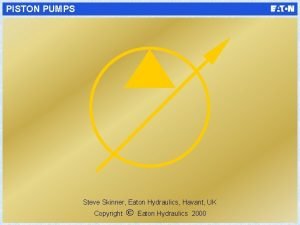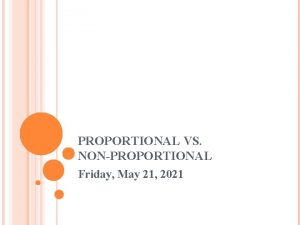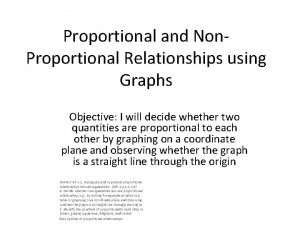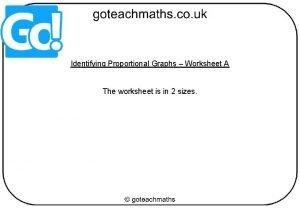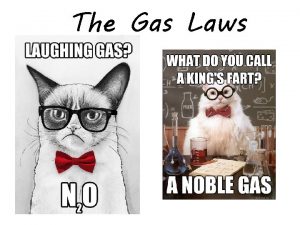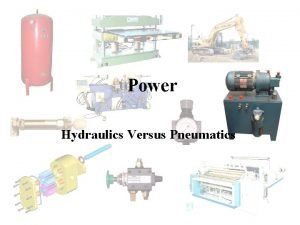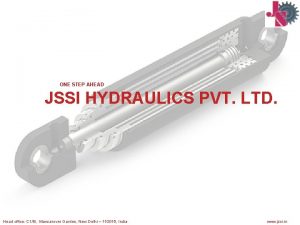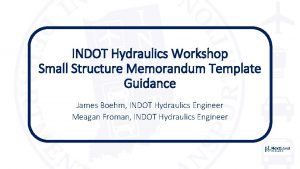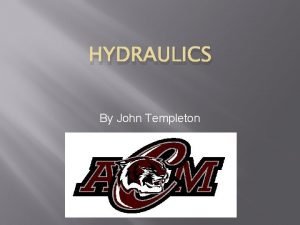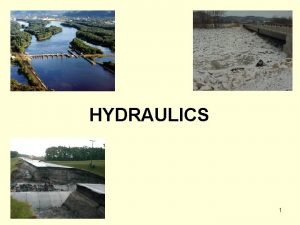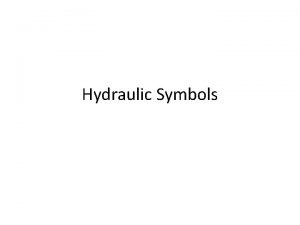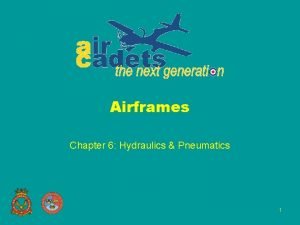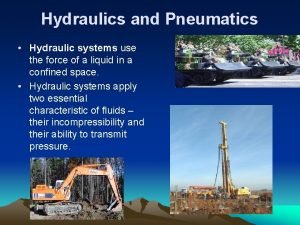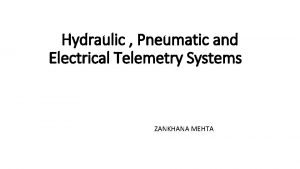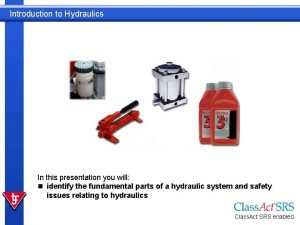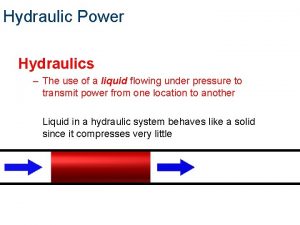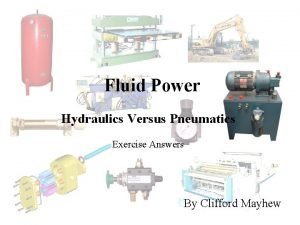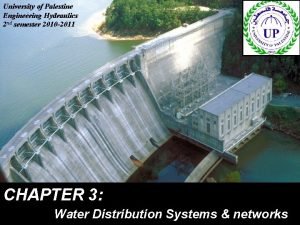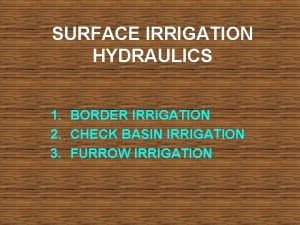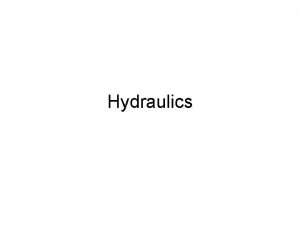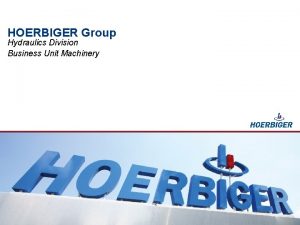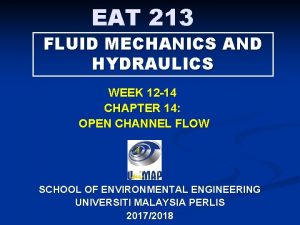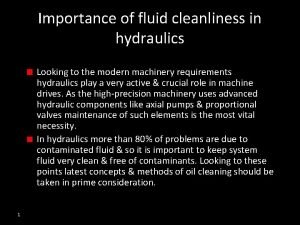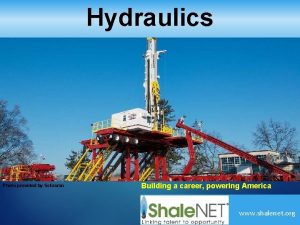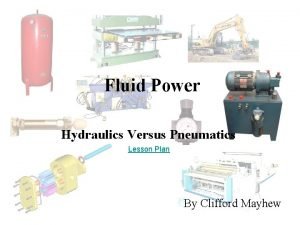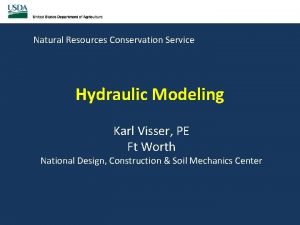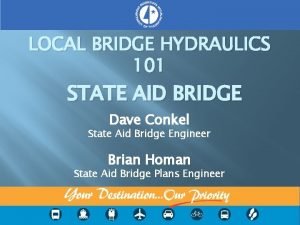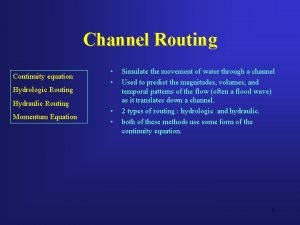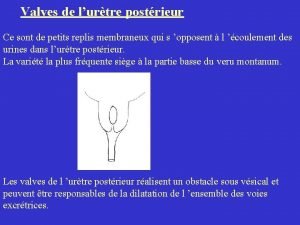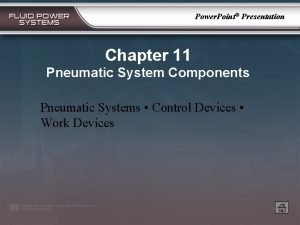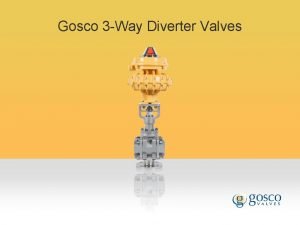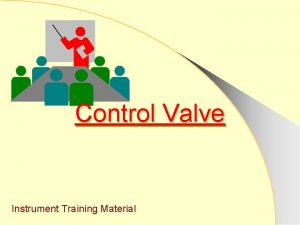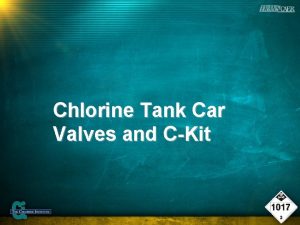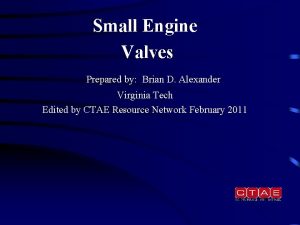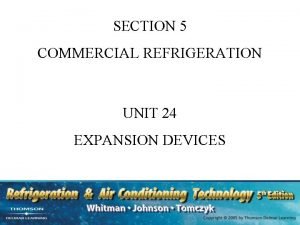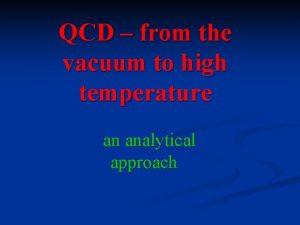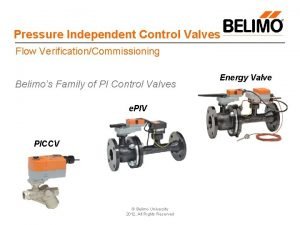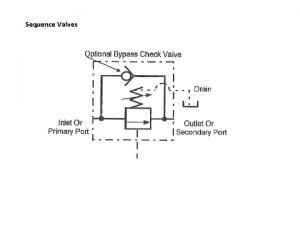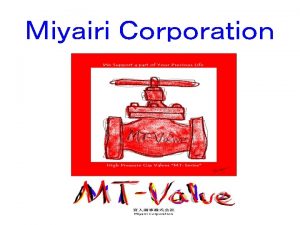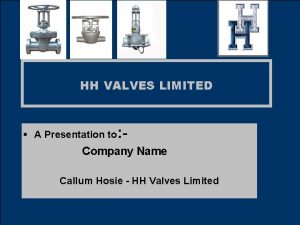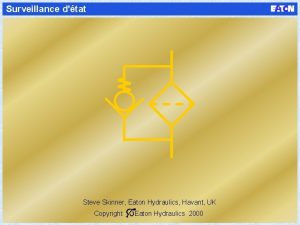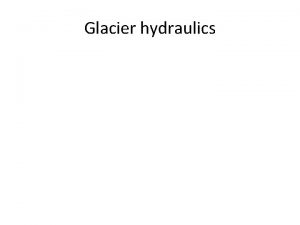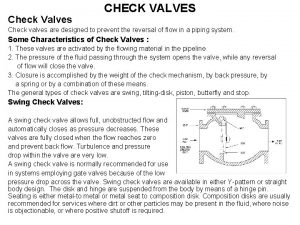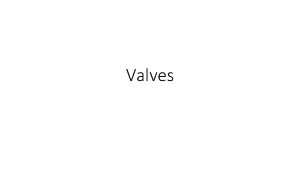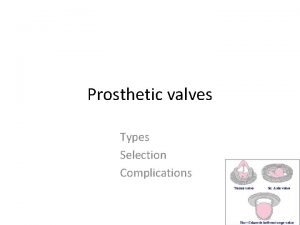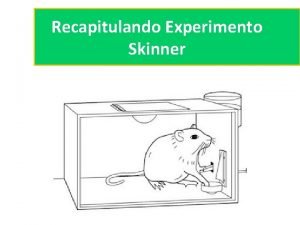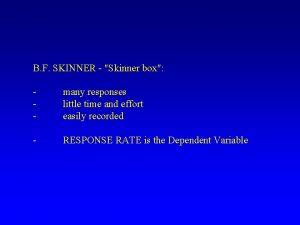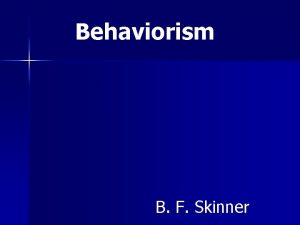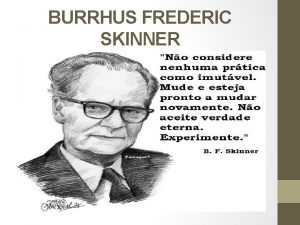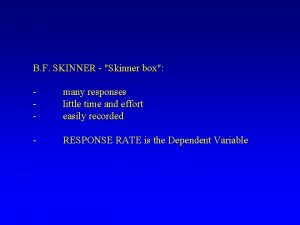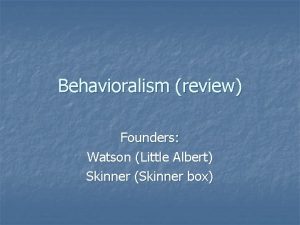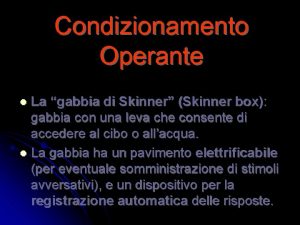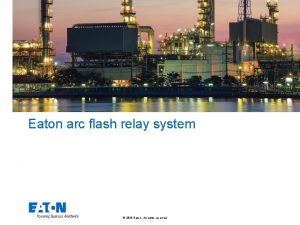Selection factors proportional valves Steve Skinner Eaton Hydraulics






























































- Slides: 62

Selection factors proportional valves Steve Skinner, Eaton Hydraulics, Havant, UK Copyright ÓEaton Hydraulics 2000

Selection factors proportional valves u Configuring the piston u Nominal flow u Performance u Control / regulation u Respone u Linearity u Repeatability u Reproducibility u Hysteresis u Pressure gain u Recovery of piston

Configuring the piston

Piston (symmetrical) input and output A A B T P 20 N T The piston is shown in the more current a proportional valve. For a given aperture, limiting the flow is the same on all ranges. In the case of an actuator with equal active areas (such as a motor), this enables a control on both the input to the output. In the case of an actuator to different active surfaces (cylinder), the order is essentially, in the direction of displacement, on the entry or exit.

Output piston A A B P T T B P 28 S T The output piston has notches at A-level spans T and BT. The limitation of the flow is relatively low in litters PA and PB (as in a conventional distributor switching). The output piston may be used in the case of cylinders and engines. It is often used for controlling negative charges.

Input piston A A B T B P T 22 A P T The KDG 4 V distributor 3 S is available only input piston. It has notches in litters PA and PB.

Asymmetric piston A A B P T T B P 20 N 10 T To ensure optimal actuators different active control surfaces, most proportional valves are available with asymmetric piston. In this case, the limitation of the flow from P to A or to B P is lower than P to B or from B to T. If, is used, for example a piston in a cylinder 2: 1, the same command can be input and output.

Symmetrical piston The advantages of an asymmetric piston can be illustrated with a simple example of an uncharged cylinder controlled by a proportional valve and a pressure compensator. 2 : 1 A B P T 8 bar

Symmetrical piston Upon retraction of the piston rod, the pressure compensator maintains a constant pressure drop of 8 bar between ports P and B of the proportional valve. 2 : 1 A B DP = 8 bar P T

Symmetrical piston As the flow from A to T is double that of P to B (relative to a cylinder of the active surfaces of 2: 1), the pressure drop from A to T is four times that of B to P (32 bar in this case). 2 : 1 A B DP = 32 bar 8 bar P T

Symmetrical piston 1) against a pressure of 32 bar on the side of the front face of the piston requires a pressure of 64 bar on the side of the rod. 2 : 1 32 bar 2) As a result it takes a mini-mum pressure of 72 bar at the port P of connec-tion to move the actuator in the absence of load. 64 bar A B 72 bar DP = 32 bar 8 bar P T

Asymmetric piston If the symmetrical piston is replaced by an asymmetric piston (2: 1), the pressure drop imposed by the balance of pressure will also 8 bar. 2 : 1 A B Piston 2: 1 DP = 8 bar P T

Asymmetric piston A 2: 1 to a 2: 1 piston associated cylinder then results also have a pressure drop of 8 bar A to T. 2 : 1 A B Piston 2: 1 DP = 8 bar P T

Asymmetric piston The against-pressure of 8 bar on the side of the front face of the piston 16 requires the side bar of the rod, and therefore a minimum pressure of 24 bar at the port P. The use of a reduced and 72 bar to 24 bar the pressure required at the piston orifice asymmetric P. 2 : 1 8 bar 16 bar A B Piston 2: 1 24 bar DP = 8 bar P T

Selection options in the piston A T P 20 N A T A B T B P 22 A T The choice of the limiting characteristic of the piston speed is determined by the type of actuator and the nature of the feedstock. T T B P 28 S A T B P 20 N 10 T

Central positions of the piston A B A B P T P T 2 C 33 C 5 C Several options for selecting the central position of the piston are also available with most proportional valves. The right choice depends mainly on the load characteristic and auxiliary valves in the system. If used, for example, a proportional valve to prevent movement of an actuator, it is possible to use a plunger 2 C. If used, however, a non-return or electromagnetically controllable control valve, a piston 33 C of the type can be more appropriate.

Nominal flow

Nominal speed of the piston 2) Various volumetric flow rates can be obtained by varying the size, shape and number of slots of the piston. QR l/min A B P T DP= 5 bar 1) The nominal flow rate is defined by a piston flow that passes a range of the piston (maximum aperture) to a pressure drop of 5 bar. QR 3 l/min 3) valves at nominal flow rate of between 3 and 550 l / min are currently available. 550 l/min

Flow calculation A 1 V 1 QR = ? The right choice of the size of a proportional valve is important because a too small distributor does not provide the required speed of the actuator. Too distributor may result in a very low piston opening, which is difficult to control.

Flow calculation A 1 A 2 F P 1 P 2 PS PT As a proportional valve limits the flow to both the inputs or outputs of the actuator, the choice of the correct size however, is not as simple as in the case of a conventional valve switching.

Flow calculation A 1 A 2 P 1. A 1 P 2. A 2 F P 2 P 1. A 1 = P 2. A 2 + F PS PT To determine the pressure drop across the valve, it is necessary to estimate the pressures P 1 and P 2. This can be done starting from the balance of forces on the piston of the jack. . .

Flow calculation A 1 A 2 F P 1 Q Q. A 2 A 1 P 2 P 1. A 1 = P 2. A 2 + F DP µQ 2 PS PT A 2 P 2 – P T = PS – P 1 A 1 2 And. . . flow ratio and losses at the metering orifice.

Sizing software The simplest approach, however, is to use software performing all the steps of the calculation.

performance

Valve performance against non-response 2) When, in a valve-free against reaction, energizes the electromagnet, there is generated a magnetic force that pushes the piston in the valve body in opposition to the force of a spring. 1) In the selection of the optimum operating speed of a proportional valve, it is also necessary to consider the performance of the valve, such as its ability to maintain the piston in the required position of the forces in spite of flow. DP Q

Valve performance against non-response 3) When, however, the valve is traversed by the fluid forces of flow is also exerted on the piston in opposition to the magnetic force. 1) The piston opens the passage until the magnetic force and the force of the compressed spring are in balance. DP 2) fully open, the flow through the valve is proportional to the square root of the pressure difference across the valve. Q

Valve performance against non-response 1) The forces of flow has the effect of closing the part in the piston, . . . DP Q 2). . . which leads to a different curve of the calculated and a limitation of the maximum possible throughput.

Valve performance against non-response As soon as the speed limit is reached, the curve can either be vertical or even regressive. In other words, an increase in pressure drop then leads to a reduction in flow through the valve. A vertical curve, however, means that a variation of the pressure drop contained no change in flow, for example in the case of a pressure compensating effect. DP Q

Valve performance against non-response Performance curve indicated thus defines the boundary of the range of user-tion of a valve for a maximum input signal; it is, for example, not possible to work outside this range. DP 4 6 Q

Valve performance against non-response Valves against reaction also limits performance, but these are generally superi-eures to those of an equivalent against valve without feedback. DP Q

Valve performance against non-response 1) When the flow forces push the piston toward the closing position, the signal of the sensor against the feedback indicates that the piston has changed position. The intensity of the injected current in the electromagnet is thus increased automatically. 2) This allows the piston to oppose the forces of flow and thus permits higher at higher flow rates through the valve. DP Q

Valve performance against non-response However, it may happen that the forces of flow become too large for the solenoid, and the valve will begin to close as before. DP Q

Valve performance against non-response The range-formance of a valve against the reaction is greater than that of an equivalent valve against without feedback control and enables higher speeds. DP Q

Control / regulation

Order Ramp 1) In a control system, generates an amplifier from an input current applied voltage to the proportional valve, which regulates the power and speed of the actuator and control its speed. Amperage voltage flow Position acceleration speed 2) A change in the load of the actuator or the system pressure, however, may vary the speed of the actuator. A throttle control and braking of the actuator can be obtained using the ramp generator of the amplifier which varies the amplitude of the variation of the output current. 3) In order to control the position of the actuator with a control system, may be used a limit detector, which cuts the voltage applied to the amplifier (the input signal and selects and zero speed of the actuator). The exact position at which stops the actuator depends, however, a series of factors (load inertia, the response time of the valve, speed, etc. . ). The accuracy of the position and therefore limited, and overrun is not corrected.

Order Ramp Amperage Rate of change force pressure Force voltage A control pressure can be obtained by use of a pressure limiter or regulator. In this case, the input voltage applied to the amplifier generates a corresponding output current applied to the proportional valve to thereby regulate the pressure at the actuator. Generator ramps integrated in the amplifier can s' used for controlling the rate of increase or decrease of the pressure.

Speed control Ramp acceleration PID + Amperage _ pressure speed voltage ¬speed voltage A speed control requires a sensor which outputs a signal proportional to the speed of the actuator against feedback. To generate an output current (or flow at the actuator) when the error signal is zero (= against feedback input), the amplifier must be an integrator. Maintaining the speed (under different loads, etc. ). Is much more accurate than in the case of a control system. As a control, a control of the acceleration and braking can be obtained using the ramp generator integrated in the amplifier.

Position control Ramp 1) A position control requires a sensor which outputs a signal proportional to the position of the actuator against feedback. PID + Amperage _ flow speed Position voltage ¬Position voltage 2) In most applications, the amplifier simply generates a current output that is proportional to the positional deviation (less against feedback input). The position accuracy is much greater than in a control system. 3) In some situations, however, it may use the integrator and differentiator amplifier to improve system performance. However, such applications require a relatively high level of experience. The ramp generator integrated in the amplifier may also be used for controlling the speed of movement of the actuator from one position to another.

Force control Ramp Rate of change force PID + Amperage pressure Force ® _ voltage For the force control, may use either a pressure sensor or a force sensor for the provision of the feedback signal against. If the command is provided by a spool valve, the amplifier typically generates an output signal including both a proportional component and an integral component. As before, the ramp generator used to control the rate of change of the cylinder force.

Response

step response flow entry output The response time of the valve is an important factor in high performance systems. This may indicate the behavior of the valve to a change in level of the input signal, which in some cases can have the shape shown here. The problem is, however, to determine the point at which the input signal and the output signal are equal. time

step response entry output 100% 90% flow In other cases, the output may exceed the input, and it is again difficult to determine the extent to which input and output signal are equal. To avoid this problem, the response time is usually indicated as the time required for the output to reach 90% of final value. T time

Frequency Response Flow (P to A) 100% entry output 75% 50% 25% Flow (P to B) time It is sometimes more appropriate to measure the performance of the valve by examining its behavior to a sinusoidal curve applied to the input. This is often obtained by oscillating the piston of the valve of roughly 25% to around 50% open position. At low frequencies, the output of the valve can almost exactly follow the input.

Frequency Response entry Flow (P to B) Flow (P to A) 100% output 75% A 2 50% 25% 360º A 1 L 1) When the input frequency increases, the output amplitude decreases; the output starts to lag behind the input signal. Amplitude response(d. B) = 20 log Phase delay (º) = L time ( ) A 2 A 1 2) Both of these effects are described by the two variables in response amplitude and phase delay.

Frequency Response Phase delay (º) Amplitude (d. B) 1) Amplitude and phase delay are measured for a series of frequencies and shall refer in a diagram with logarithmic scale. It is known Bode diagram. -3 bandwidth 1 10 100 Frequence (Hz) 2) The frequency at which the output is reduced by 3 d. B (50%) is known as bandwidth. The cutoff frequency is the frequency corresponding to a phase lag of 90 º. One or more of these values are normally used to determine the response of the valve. 135 90 45 1 10 100 Frequence (Hz) Frequence break

Linearity

Linearity E Outflow QMAX In control systems, in particular, it is often important to have a linear relationship between input signal and the valve output flow. The linearity of the valve quantifies the quality of compliance with this condition. Linearity (%) = Input signal E QMAX x 100

Repeatability

Repeatability E QMAX Outflow Signal Repeatability (%) = successive applications a single signal (same valve) E QMAX x 100 The repeatability accuracy measurement with a valve which generates a desired output is applied and removed when the same signal. This is important in control systems in order to ensure the smooth operation of a machine.

Reproducibility

Reproducibility E QMAX Outflow Signal Reproducibility (%) = successive applications a single signal (different valves) E QMAX x 100 Reproducibility is a similar measure, but refers to the same signal applied to the various valves.

Hysteresis

Hysteresis QMAX Outflow Hysteresis describes the difference between the input signal increasing and decreasing input required to obtain a desired output signal. E Input signal IMAX Hysteresis (%) = E IMAX x 100

Pressure gain

Pressure gain The gain pressurizing valve measures the speed with which the piston opens and closes the work ports of the valve when the piston moves to one side or the other of the central position.

Pressure gain Leaving its central position, the piston gradually opened communication (A) to (P) and closes (T). This is the opposite to the hole (B). A T B P T

Pressure gain Once the piston has traveled a certain distance (typically equal to 3 -4% of its total course), the orifice (A) is the maximum pressure, and the port (B) to the reservoir pressure. In many control systems requires a high pressure gain for the valve to respond to also correct errors very small. A PD B T PPS T PD PS 1 2 3 4 % entry

Recovery of piston

Recovery of piston zero overlap positive overlap In some cases, it is possible to specify the nature of recovery proportional piston. A piston positive overlap reduces leakage in central position, a piston recovery often giving a negative system extremely fast response (pistons zero overlap exist only in theory). negative overlap

erla p positive overlap ove rlap ativ e ov pos itiv e neg Outlet pressure Recovery of piston Input signal negative overlap The nature of recovery influences the pressure gain, as can be seen here. A positive overlap leads to a dead zone, wherein the outlet area does not change as the input signal does not exceed a certain threshold. In control systems, valves positive overlap (to reduce leakage) associated with electronic compensation to reduce the actual dead zone is often used. Control valves, they normally use pistons negative overlap for maximum control.

Application Instructions yes poss. not control shocks Acceleration. order speed regulation position regulation pressure This diagram shows the typical application areas for various types of proportional valves. As always, there is, again, exceptions. VALVE

Selection factors proportional valves Steve Skinner, Eaton Hydraulics, Havant, UK Copyright ÓEaton Hydraulics 2000
 Eaton havant
Eaton havant Proportional vs nonproportional
Proportional vs nonproportional Non-proportional graph
Non-proportional graph Inversely proportional
Inversely proportional Proportional vs non proportional graphs worksheet
Proportional vs non proportional graphs worksheet Indirectly proportional
Indirectly proportional How to tell if something is proportional
How to tell if something is proportional Steve jobs steve wozniak ronald wayne
Steve jobs steve wozniak ronald wayne Hydraulics and pneumatics symbols
Hydraulics and pneumatics symbols Jssi hydraulics
Jssi hydraulics Indot design memo
Indot design memo Hydraulics definition
Hydraulics definition Hydraulics definition
Hydraulics definition Unidirectional hydraulic motor symbol
Unidirectional hydraulic motor symbol Hydraulic advantages
Hydraulic advantages Hydraulics & pneumatics
Hydraulics & pneumatics Introduction to hydraulics and pneumatics
Introduction to hydraulics and pneumatics Pneumatic telemetry system
Pneumatic telemetry system Introduction to hydraulics and pneumatics
Introduction to hydraulics and pneumatics Hydraulics
Hydraulics Fluid power terms crossword
Fluid power terms crossword Palestine hydraulics
Palestine hydraulics Advantages of border irrigation
Advantages of border irrigation Hydraulics
Hydraulics Press brake hydraulic diagram
Press brake hydraulic diagram Hydraulics
Hydraulics Space coast hydraulics
Space coast hydraulics Cleanliness in hydraulics
Cleanliness in hydraulics Professional hydraulics
Professional hydraulics Give the standard graphical symbols for frl unit
Give the standard graphical symbols for frl unit Hydraulics karl lagerfeld
Hydraulics karl lagerfeld Hydraulics 101
Hydraulics 101 Khan academy hydraulics
Khan academy hydraulics Toon verwaest
Toon verwaest Continuity equation hydrology
Continuity equation hydrology Hydraulic routing methods
Hydraulic routing methods Balancing selection vs stabilizing selection
Balancing selection vs stabilizing selection Artificial selection vs natural selection
Artificial selection vs natural selection K selected
K selected Natural selection vs artificial selection
Natural selection vs artificial selection Difference between continuous and discontinuous variation
Difference between continuous and discontinuous variation Directional selection example
Directional selection example K selection r selection
K selection r selection Natural selection vs artificial selection
Natural selection vs artificial selection Two way selection and multiway selection
Two way selection and multiway selection Multiway selection
Multiway selection Procedure of pure line selection
Procedure of pure line selection Valve de l'urètre postérieur
Valve de l'urètre postérieur Nssl valves
Nssl valves Pneumatic valves ppt
Pneumatic valves ppt Gosco valves
Gosco valves Obiggs valves
Obiggs valves Control valve flow characteristics
Control valve flow characteristics Chlorine c kit
Chlorine c kit Types of pressure control valves ppt
Types of pressure control valves ppt Small engine valves
Small engine valves External equalizer expansion valve
External equalizer expansion valve Meson valves
Meson valves Picv valve symbol
Picv valve symbol Beekay steel industries ltd
Beekay steel industries ltd Pressure sequence valve symbol
Pressure sequence valve symbol スリップチューブ式液面計
スリップチューブ式液面計 Hh valves ltd
Hh valves ltd
